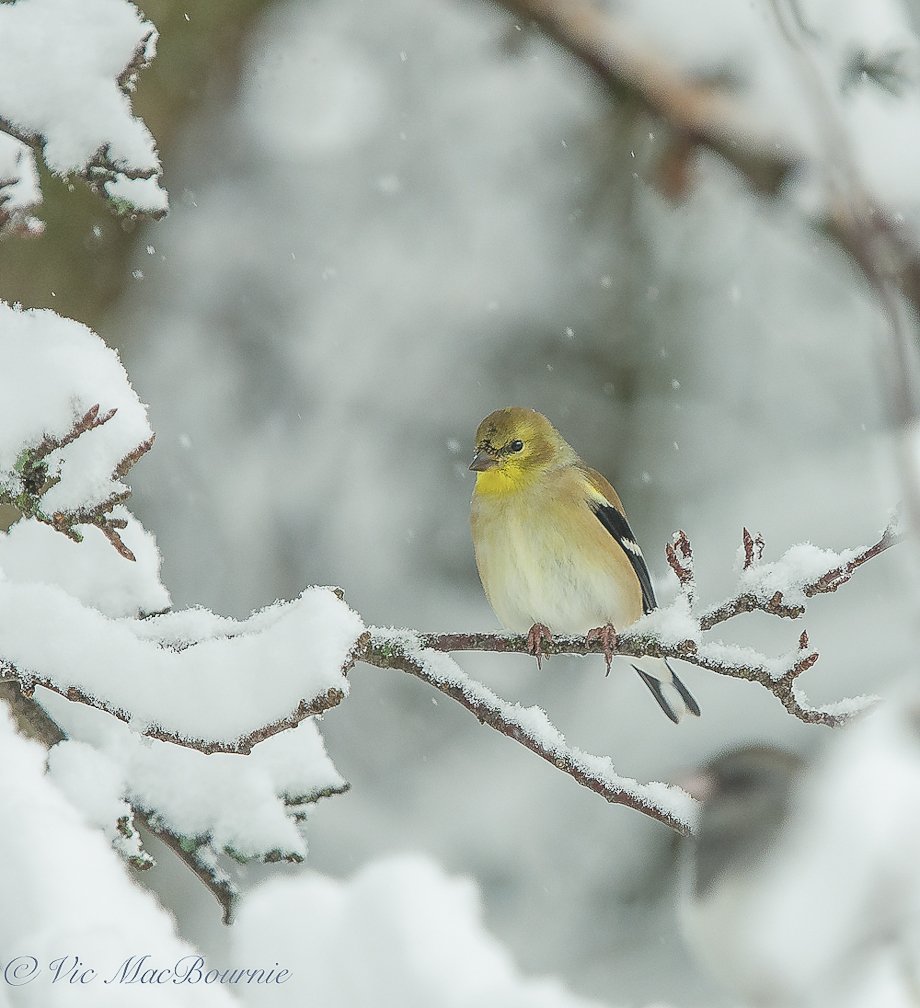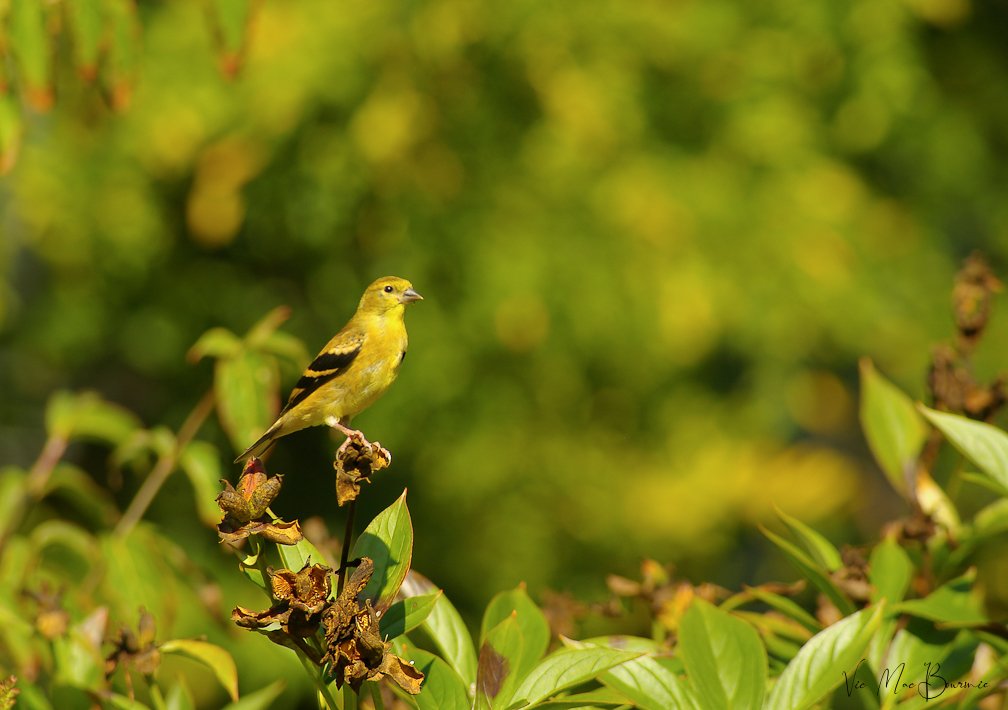How do our bright yellow Goldfinches get their colour
A digital watercolour image of an American Goldfinch sitting out a winter storm.
Bright yellow bird’s colour change and the common thistle
The story of the American Goldfinch’s bright yellow colour and why it changes from a drab greyish brown in winter to a stunning bright yellow in early spring really begins with, and is tied to, its diet of almost entirely seeds – primarily seeds from its favourite food, the thistle plant.
If you want these colourful “wild canaries” in your woodland garden, let the thistles grow in a corner of your yard or, if you want to watch these beautiful little finches attack your thistles, plant them near your favourite sitting area or a window. Be sure to include sunflowers and milkweed as well for some spectacular late summer entertainment.
What you will notice is that later in summer these thistles and other native plants will begin to flower and put out seed just in time for the Goldfinches to take advantage of this abundance of seed to feed their, most likely, one and only brood of nestlings.
Okay, so what does this have to do with the male Goldfinch taking on its bright yellow spring colour and the female’s subtle soft yellow coat?
It is thought that the timing of the moult and the transformation into its beautiful yellow plumage in spring is related, at least in part, to natural seed production. The Goldfinch’s late winter/spring moult is unusual because most birds can’t use up that much energy in spring when they are trying to raise their nestlings, but because Goldfinches depend almost entirely on the consumption of seed, they are able to nest later in the season following a spring moult.
American Goldfinches are unusual among goldfinches in moulting their body feathers twice a year, once in late winter and again in late summer. The late summer moult takes place after the nestlings are born and are more independent of their parents.
Of course, the male’s bright colour relates to the mating season, but unlike most birds that begin nesting in early spring timed in part to the explosion of insect and larvae life that feeds their nestlings, Goldfinches breed later and feed its nestlings almost entirely seeds.
Check this link for more on the American Goldfinch and attracting colourful birds to your yard
An American Goldfinch quietly waiting for its turn at the Nyjer bird feeder during an early winter snowstorm that helps explain the bird’s still-vibrant plumage colours.
When do Goldfinches begin nest building?
Goldfinches don’t begin their mating ritual and nest building until later in the summer – June and July in the eastern part of their range and as early as May and June in their western ranges. By this later date, the transformation from drab, easily overlooked birds to the stunning yellow plumage of the males and more subtle yellow of the females is usually completed. In fact, by late April the moult is usually complete and the birds can begin building back any energy lost as a result of the moult.
The birds’ almost entire dependency on small seeds also mean they don’t need to rely on insects. This is particularly helpful during winter months when insects are in short supply and helps explain the fact that few of the birds migrate far distances if at all.
Moving water proves too much of an attraction for these male and female American Goldfinches. The male can be seen with its black cap waiting for its turn in the bird bath.
Cool facts about the Goldfinch
The Cornell Lab of Ornithology, in their informative website, provided some of the following facts:
Goldfinches incorporate the fibrous seeds of thistle and milkweed, which they also use to feed their young, into their nests.
Goldfinches begin moulting in September, and continue for six to eight weeks During this time they molt all of their feathers, ending up with a completely new set of drab-coloured feathers heading into winter.
In the spring, as new body feathers are grown, the males especially transform into bright yellow breeding plumage, but the wing and tail feathers remain from the previous fall.
American Goldfinches are among the strictest vegetarians in the bird world, only inadvertently swallowing an occasional insect.
American Goldfinch nestlings usually leave the nest two weeks after hatching but continue to be fed by the parents for a period of time.
Although American Goldfinches traditionally only have one brood, an experienced couple may have a second brood. In this case the female builds the new nest while the male continues to feed the first brood.
Brown-headed Cowbirds that lay eggs in an American Goldfinch nest can’t survive on the all-seed diet and perish quickly.
The oldest known American Goldfinch was 10 years 9 months old when it was recaptured and rereleased during a banding operation in Maryland.
A Golfinch looks for seed in the Woodland Wildlife garden where it feeds almost entirely on the seed of native plants and trees.
Where do Goldfinches get this bright yellow colour
This cheerful bright yellow plumage of the male Goldfinch and to a lesser degree the females comes from carotenoids in the plants and plant seeds that they ingest.
The Cornell Lab of Ornithology explains in their article on How Birds Make Colourful Feathers that: “Carotenoids are responsible for the bright yellows seen in goldfinches and Yellow Warblers as well as the brilliant orangish yellow of the male Blackburnian Warbler. Carotenoids can interact with melanins to produce colours like the olive-green of the female Scarlet Tanager.”
Some bird species, whose feathers remain the same colour year round, such as the Cardinal, Blue Jay or Chickadee, the annual moult serves to simply refresh their plumage. Others, like the Goldfinch, use the moult as an opportunity to change their colours from vibrant breeding ones to those that help to camouflage them from predators. The bright yellow plumage of the Goldfinch would do little to hide them in the stark winter landscape. For American goldfinch, that means going through a second moult in the spring, to regain their bright breeding colours.
What other natural seeds do Goldfinches eat?
Thistles are not the only seeds eaten by these small birds. Their strong beaks allow them to open an assortment of seeds including another one of their favourites – sunflower seeds. They also eat seeds from asters, wild grasses and several trees including alder, birch, western red cedar and elm.
Most of us are familiar with the popular (but expensive to purchase) Nyjer seed which is used almost exclusively in special feeders to attract these birds. Although most people think Nyjer seed is the seed of the thistle plant, it is actually the similarly small, thin, black seed from the African yellow daisy (Guizotia abyssinica). Though unrelated to the thistle plant, it is high in oil and a popular source of food for the Goldfinch.
What to do if Goldfinches are not eating your Nyjer seed
Nyjer seed should always be purchased from a reputable seller preferably one that has a high seed turnover because older seed quickly dries out and loses its nutritional benefits. If you notice that finches stop eating from your feeder despite the fact it is full of Nyjer seed you may have just recently put out for them, it is likely that the oil in the seed has dried out and it is no longer useful. At that point it is best to dispose of it and purchase new, fresh seed.
In addition, Nyjer seed is easily spoiled when it gets wet. Even condensation building up at the bottom of the tube feeder can cause the seed to go rancid. Replace and clean the feeders on a regular basis to keep the Goldfinches coming back regularly.
If American Goldfinches are coming regularly to your feeder, September and October is a good time to pay particular attention to them. It is at this time of year that they transition from their stunning golden colour to gray.
Once the transformation is complete the Goldfinches can still be identified by their wings which are mostly black with a thick, buffy bar and white edging during flight.
In conclusion
As Woodland Wildlife gardeners we are often told about the importance of using native plants in our gardens to not only help protect these often threatened species, but to provide birds, pollinators and other predators with a critical food source – either pollen and nectar or the protein provided by insects and caterpillars who live off of them.
The American Goldfinch provides the perfect example of how these native plants provide an important source of food in the form of seeds. In fact, the entire life cycle, mating, giving birth, even moulting is dependent in some way on the production of seeds from a specific group of plants and trees.
For the ill informed, these critical plants, namely thistle and milkweed, are not often desirable plants to have in our gardens and are shunned by many traditional “tidy up” gardeners.
Maybe these gardeners would prefer to pay for an endless supply of Nyjer seed to feed the few Goldfinches that are passing through rather than let the birds natural food source grow in a corner of their yard.
Never has it been more important to embrace native plants and because of the dwindling supply of natural seeds you may be doubly rewarded for your efforts to grow these critically important native plants.




